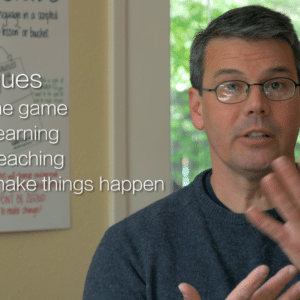
It is important to know where you are and to be in the moment. You can easily get confused if you don’t practice “Being Here Now.”
This post is fourth in a series of entries about WAYK techniques as they occur in everyday life, beyond language-learning. The previous three are on “Craig’s List” and “Full,” and “Everybody Deals.”
Imagine for a moment that you’re painting a sunset, pondering the precise color combinations from your palette that encapsulates the unique hues of the sun on the horizon. You obsess over the right number of drops of yellow paint to add to red paint. After minutes of careful calibration, you finally develop the first color you need. Next, you need to find a color that’s different from the first color, but not too much so. Over time, you repeat this process for the colors of the entire sun, and you wonder how smooth the transition between each color should appear. Hours pass, and you are finally finished–but the rest of the sky is blank, still awaiting the time you paint it into being.
Is it hard to imagine the details of this process and the shapes and colors involved? If you’re a prolific painter, it’s probably not all that difficult, but otherwise, it may be quite a challenge because you have to organize and compose your thoughts from scratch or only from vague past experience. You have to think longer as a result.
Realizing that merely imagining situations was a learning decelerator, WAYK players developed the technique “Be Here Now”, which make set-ups more obvious by forcing language hunters to be in situations in which language can be used in their actual context. When we in the Stanford Languages Club invited Danya, a native Arabic speaker from the northeast of Saudi Arabia, we pondered whether we should hunt Modern Standard Arabic or the variety of Arabic peculiar to Danya’s home area. David Edwards called “Be Here Now”, pointing out to all of us that because we were all young college students, we should be speaking Danya’s colloquial Arabic as she would use it with her friends back home. We had no worries about sounding stilted or unrealistic. We felt more into the moment, knowing we were talking a lot more like natural Arabic speakers in our age group.
The more reality you bring into the game and the more tangible you make it, the better the experience. If you already know “what is this?” and “want”, you can learn how to order food from a restaurant that speaks your target language. Role-playing with another speaker in a classroom may not quite secure in your mind the expressions that will be useful to you. Instead, if you can, you should actually go to the restaurant and point out to your waiter which delicacy on the menu you’d like, using the language you’ve already picked up. Bonus points for language learning if the restaurant has picture menus: you can ask “what is this?” in the language, then say you want it.
Tina Seelig, in her book of advice What I Wish I Knew When I Was 20, recounts that she felt much more engaged in her neuroscience studies when she was working in laboratories than when she was having lessons in classrooms. She learned faster through a direct, visual, hands-on approach rather than through abstractions and theories on paper. You’ve likely had many field trips during school at zoos, factories, and plays: you learn more readily how animals behave, how your favorite goods are made, how people perform as other characters (in real time, not recorded and projected on a screen!). If you have a job, can drive, or both, you’ve most likely had technical, tangible training and practice rather than mere spoken or written instructions. As it’s often said, driver’s education happens behind the wheel.
Perhaps more importantly, “Be Here Now” in WAYK compels you to pay close attention to the game, the spoken words, and the objects in front of you as much as possible so that you can pick them up. If you want to learn bicycle repair, have a broken bicycle in front of you. If you want to learn computer programing, have a program you’re working on in front of you. Teachers and students accelerate learning once they have concrete items in front of them.




